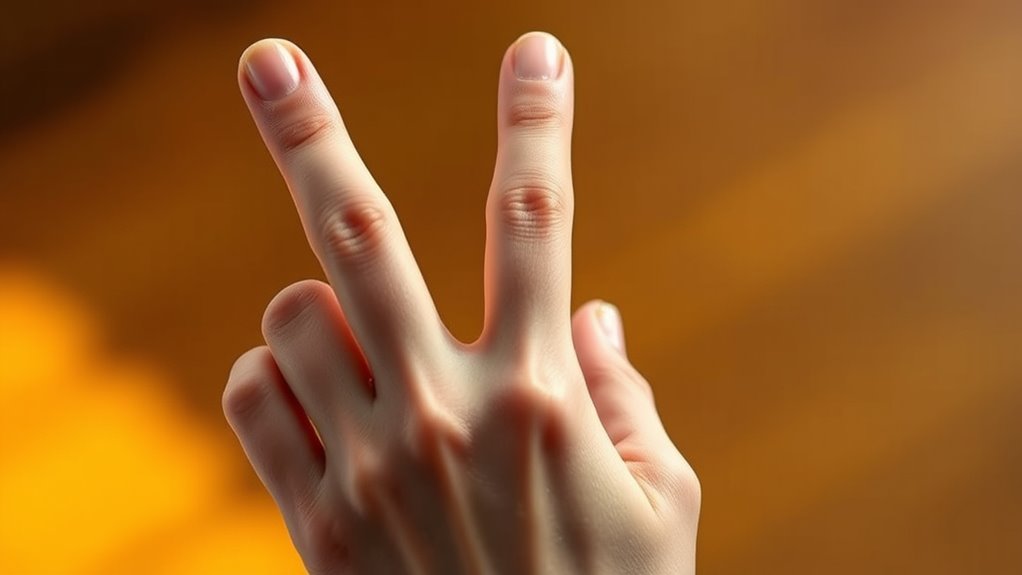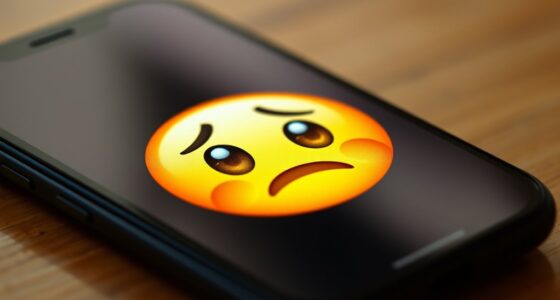The 🤌 emoji is commonly used to show approval, finesse, or mastery, often resembling a chef’s kiss or pinched fingers symbolizing something done perfectly or stylishly. It’s versatile and can express taste, skill, or admiration in digital conversations. Depending on context, it might also be playful or sarcastic. To understand how this emoji can add meaning to your messages and its cultural nuances, exploring further can give you helpful insights.
Key Takeaways
- The 🤌 emoji represents approval, finesse, or mastery, often symbolizing a “chef’s kiss” or perfect quality.
- It originates from Italian hand gestures used to emphasize or approve something.
- Commonly used to show admiration for skill, tasty food, or stylish behavior in casual conversations.
- The emoji can also carry cultural nuances, sometimes used sarcastically or humorously.
- Its meaning may vary based on context, platform, and audience, reflecting social trends and cultural differences.
The Origin and Evolution of the 🤌 Emoji

The 🤌 emoji, often called the “pinched fingers” or “chef’s kiss,” has a surprisingly recent origin. Its emoji history traces back to Italy, where the gesture originates from traditional Italian hand gestures used to emphasize a point or express perfection. The gesture’s roots lie in gesture origins that date back centuries, symbolizing approval, precision, or asking “what do you want?” Over time, digital communication popularized this hand sign as an emoji, capturing its expressive nature. The emoji’s evolution reflects a shift from cultural gesture to a universal symbol conveying excellence, approval, or a refined touch. Today, it’s become a recognizable part of online conversations, blending tradition with modern digital expression. Understanding gesture origins highlights how cultural expressions influence modern digital symbols.
Common Uses and Contexts for the 🤌 Emoji

You’ll often see the 🤌 emoji used to express approval, satisfaction, or admiration in various online interactions. Its emoji interpretation can vary across different cultural expressions, making it versatile in conveying nuanced emotions. People use it to highlight something they find impressive, refined, or “top-notch,” especially when praising a skill or quality. In digital conversations, the 🤌 emoji adds a layer of authenticity and enthusiasm, acting as a visual cue that emphasizes finesse or excellence. It’s frequently employed in social media posts, comment sections, and messaging apps to celebrate achievements or commend stylish behavior. Its popularity stems from its ability to quickly communicate a sense of pride or approval without needing words, resonating across diverse cultural contexts. Understanding the Relationship dynamics behind emojis like 🤌 can enhance how we interpret emotional cues in digital communication.
How the 🤌 Emoji Conveys Approval and Fineness
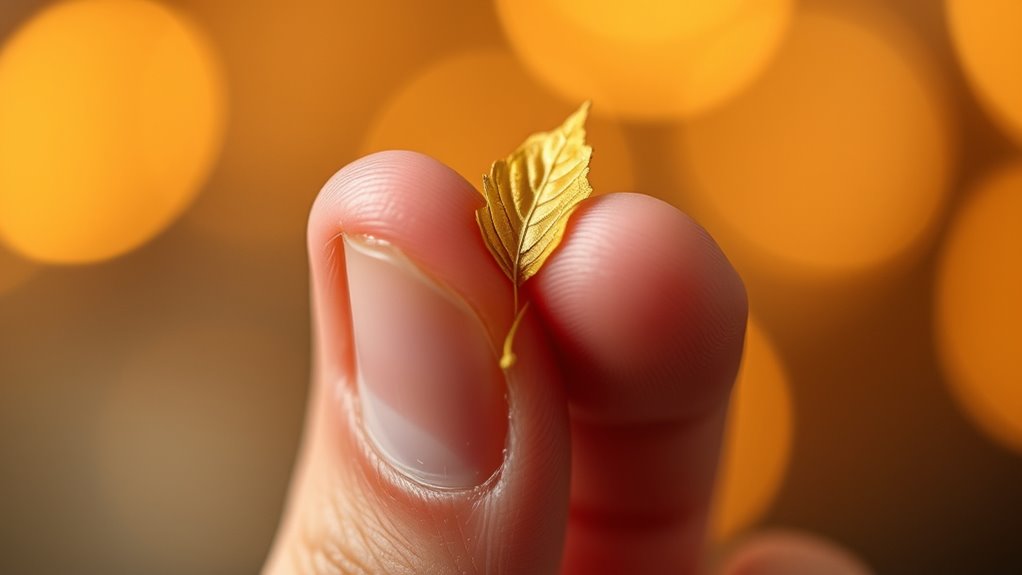
When you see the 🤌 emoji, it often signals approval or admiration for something exceptional. You might use it to highlight culinary excellence, show appreciation for craftsmanship, or endorse top-tier quality. This emoji effectively communicates that something stands out as refined and impressive. It also reflects a sense of sustainable appreciation, emphasizing mindful recognition of quality and effort.
Expressing Culinary Excellence
The 🤌 emoji has become a popular way to signal culinary excellence and finesse in digital conversations. Its use taps into culinary symbolism, where small gestures often represent mastery and sophistication. When you see this emoji, you’re likely acknowledging a dish or a chef’s skill as top-notch, emphasizing quality and refinement. In emoji communication, it acts as a visual shortcut to express approval of something that’s expertly crafted or exceptionally tasty. Whether you’re complimenting a homemade meal or praising a restaurant’s menu, the 🤌 emoji conveys that the culinary effort is impressive and deserving of recognition. This simple symbol, thus, enhances your message by highlighting a sense of finesse tied to food, making your appreciation clear and culturally relevant. Additionally, emoji usage reflects modern communication trends, making interactions more engaging and expressive.
Indicating Precise Craftsmanship
The 🤌 emoji effectively signals approval and appreciation for precise craftsmanship because it visually mimics a delicate pinch or a small, skillful gesture. When you use it, you’re expressing admiration for fine work and craftsmanship appreciation. It’s a subtle way to highlight skillful details that require precision. The emoji acts as a form of precision communication, indicating that something is carefully crafted or executed with finesse. Here’s a quick look at how it functions:
| Craftsmanship Appreciation | Precision Communication | Skillful Gesture |
|---|---|---|
| Recognizes quality | Clarifies intent | Shows finesse |
| Highlights detail | Emphasizes skill | Implies mastery |
| Celebrates finesse | Confirms excellence | Signifies approval |
Using 🤌, you acknowledge artistry and mastery in a concise, visual way. Additionally, understanding the concept of visual language helps explain why emojis like 🤌 are effective in conveying nuanced messages quickly.
Signaling Top-tier Quality
Building on its role in highlighting craftsmanship, the 🤌 emoji also signals top-tier quality and excellence. It’s often used in culinary symbolism to show when a dish is exceptional or perfectly prepared. You might see it as a gesture comparison to indicate something’s fineness or sophistication. When you use this emoji, you’re expressing approval for something that’s truly outstanding. It’s like giving a nod that the quality is premium. This subtle gesture communicates that the item or experience exceeds expectations. Whether appreciating a gourmet meal or a finely crafted piece, the 🤌 emoji elevates your message, signaling that what you’re endorsing is truly top-tier. Moreover, the use of this emoji can reflect an appreciation for AI-generated content’s quality, especially as AI tools become more integrated into creative and professional outputs, emphasizing the importance of high standards.
Cultural Variations in Interpreting the 🤌 Emoji

You might find that the 🤌 emoji is understood differently depending on cultural context. In Western countries, it often signals approval or excellence, while in Eastern cultures, it can carry more nuanced or even humorous meanings. Recognizing these variations helps you use the emoji appropriately across formal and casual conversations worldwide. Additionally, understanding self-awareness can further improve your ability to interpret and use emojis effectively in communication.
Western vs. Eastern Use
Cultural context heavily influences how people interpret the 🤌 emoji, especially when comparing Western and Eastern perspectives. In the West, the gesture often signifies precision, excellence, or something well-done. Conversely, in parts of Eastern Asia, it can represent a food-related gesture, like savoring a delicious bite, or even a symbol of money. These differences highlight how gesture meanings can vary widely across cultures. As the emoji evolution continues, users adapt its meanings to fit their social norms. Recognizing these distinctions helps you avoid misunderstandings and appreciate cultural nuances. To summarize:
- Western use focuses on perfection or quality
- Eastern use often relates to food or wealth
- Gesture meanings evolve with social trends
- Cultural context shapes emoji interpretation
- Cultural variations play a key role in understanding emoji meanings
Being aware of these variations enhances your communication across cultures.
Formal vs. Casual Contexts
The way people interpret the 🤌 emoji can change considerably depending on whether the setting is formal or casual. In casual conversations, using this emoji often aligns with relaxed emoji etiquette, conveying enthusiasm, pride, or a stylish gesture. However, in formal contexts like professional messages or official communications, it’s better to avoid using it altogether, as it might seem too informal or inappropriate. Cultural expressions also play a role; in some cultures, the 🤌 emoji might be seen as a playful or trendy symbol, while elsewhere, it could be misunderstood or considered disrespectful. Knowing your audience helps you decide when and how to include the 🤌 emoji, ensuring your message stays respectful and clear across different contexts. Additionally, understanding cultural variations can help prevent misinterpretations when using emojis like 🤌.
Cultural Nuances and Trends
Have you ever noticed how the 🤌 emoji can mean different things depending on where you are? Cultural nuances heavily influence its interpretation in digital communication. In some regions, it’s seen as a sign of excellence or perfection, while in others, it might be used to express sarcasm or dismissiveness. Understanding emoji etiquette across cultures helps you avoid misunderstandings. Trends also shape its meaning; for example, in Italy, it’s linked to culinary excellence, whereas elsewhere, it can signify precision or emphasis. Recognizing regional differences in emoji usage is essential for effective cross-cultural communication.

Wondering when to incorporate the 🤌 emoji into your social media posts? It’s best used when you want to highlight something impressive, delicious, or expertly done. Keep in mind emoji etiquette—using it sparingly guarantees your message stays authentic and engaging. Consider your social media tone: if you’re aiming for fun and lively, the 🤌 emoji fits perfectly to add emphasis and personality. Avoid overusing it to prevent your posts from feeling cluttered or insincere. Use it to celebrate a win, share a tasty dish, or underscore a clever comment. When used thoughtfully, the 🤌 emoji can make your posts more relatable and expressive without overwhelming your audience. Balance is key to maintaining an engaging and polished social media presence. Additionally, understanding emoji etiquette can help you use symbols like 🤌 more effectively and appropriately.
The 🤌 Emoji in Professional and Casual Conversations
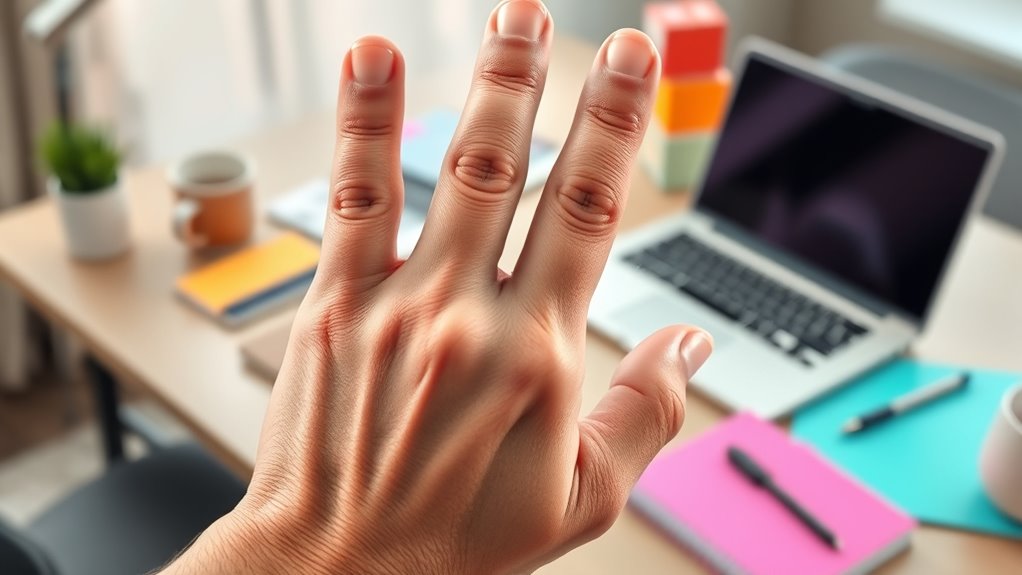
While the 🤌 emoji can add flair to casual social media posts, its use in professional conversations requires careful consideration. You should be mindful of emoji etiquette to avoid miscommunication or appearing unprofessional. In casual chats, the 🤌 emoji often signals approval, excellence, or a “chef’s kiss” moment, making digital expressions more lively. However, using it in formal emails or work messages might seem inappropriate or overly informal. To navigate this, consider the context and your audience. Here are some tips:
Use the 🤌 emoji sparingly; it’s great for casual chats but may seem unprofessional in formal communication.
- Use in relaxed team chats or informal updates
- Avoid in official or client communications
- Match emoji use with company culture
- Remember that tone can be misunderstood in digital expressions
Being selective helps maintain professionalism while still adding personality to your conversations. Additionally, understanding how emojis like 🤌 are perceived can help you better interpret the tone of digital communication, especially when it involves cultural differences.
Comparing the 🤌 Emoji to Similar Gestures and Symbols
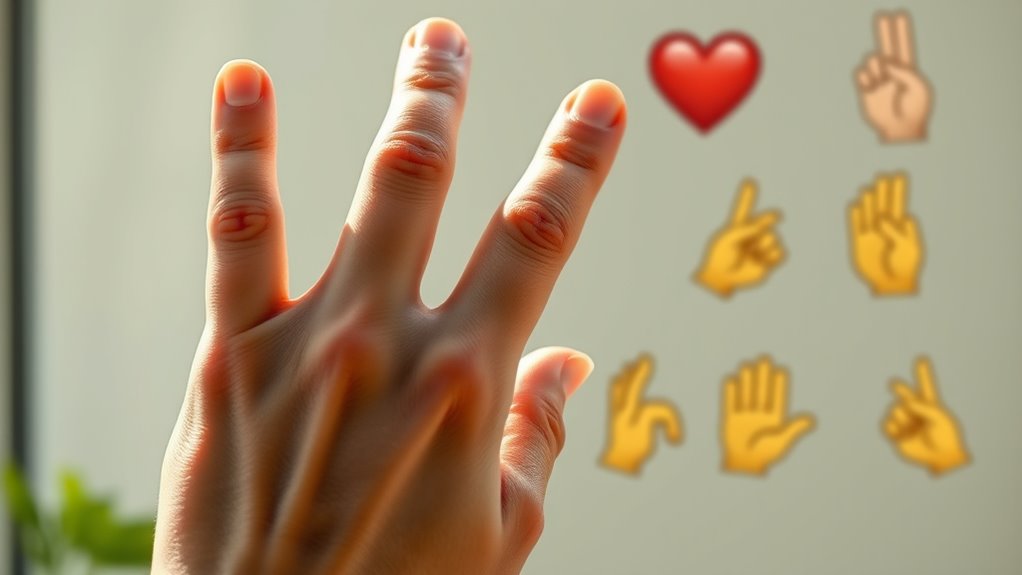
The 🤌 emoji closely resembles gestures like the “chef’s kiss” or pinching fingers to show something is perfect or tasty. These hand gesture origins date back centuries, often used by chefs and food lovers to express culinary excellence. The emoji design history reflects this cultural significance, capturing the hand’s delicate pinching motion in a simple, recognizable symbol. Unlike other symbols, such as a thumbs-up or a high five, the 🤌 emoji emphasizes finesse and approval with a subtle, refined gesture. Its resemblance to traditional hand signs helps communicate appreciation or excellence visually. Comparing it to similar gestures, you see how the emoji encapsulates a nuanced expression that has been used across cultures and generations, now modernized for digital communication. This evolution showcases how AI-generated content can influence how we interpret visual symbols in contemporary settings.
The Role of the 🤌 Emoji in Pop Culture and Trends

The 🤌 emoji has quickly gained popularity in pop culture, becoming a symbol of style, sophistication, and culinary expertise that fans and creators alike embrace. Its emoji symbolism extends beyond food, often representing excellence, finesse, or approval in various contexts. Cultural interpretations of this gesture vary worldwide, but on social media, it’s widely used to convey a sense of flair or mastery. You’ll see it in memes, TikTok videos, and influencer posts, often highlighting a moment of perfection or pride. Its role in trends emphasizes authenticity and appreciation for craftsmanship. Additionally, the gesture has become associated with Volkswagen Tuning culture, where it signifies skillful customization and mastery of vehicle modifications.
The 🤌 emoji symbolizes mastery, finesse, and approval across social media and pop culture.
- Popular in food-related content and cooking videos
- Used to express approval or “chef’s kiss” moments
- Symbolizes confidence and mastery in pop culture
- Frequently adopted in meme culture for humor and emphasis
Tips for Appropriately Incorporating the 🤌 Emoji

When using the 🤌 emoji, you want to make sure your message fits the situation. Think about the context and tone to avoid misunderstandings. A little awareness can help you use the emoji effectively and appropriately. Incorporating appropriate emojis in communication can enhance clarity and emotional expression, especially in digital conversations.
Tips for Appropriately Incorporating the 🤌 Emoji
To effectively incorporate the 🤌 emoji into your messages, consider the context and tone of your communication. Understanding its cultural significance helps guarantee you’re using it appropriately. Follow basic emoji etiquette to avoid misinterpretation or offense. Here are some tips:
- Use it sparingly to avoid overwhelming your message.
- Match the emoji to the mood—it’s great for playful or confident expressions.
- Be mindful of your audience’s familiarity with the emoji’s meaning.
- Avoid using it in formal or serious conversations to maintain professionalism.
Context Is Key
Since the 🤌 emoji can convey different meanings depending on the situation, paying attention to the context is vital for using it appropriately. Understanding linguistic symbolism helps you grasp how this emoji evolves within conversations and cultural shifts. As emoji evolution continues, the 🤌 emoji’s meaning can shift from a gesture of precision to a symbol of approval or even sarcasm. To use it effectively, consider the tone of your message and your audience’s expectations. For example, in casual chats, it might express something impressive, while in more formal settings, it could be misunderstood. Being mindful of the context ensures your intent aligns with how others interpret the emoji, helping you communicate clearly and avoid misinterpretation. Additionally, awareness of emoji symbolism enhances your ability to interpret subtle nuances in digital communication.
Future Trends and How the 🤌 Emoji Might Evolve
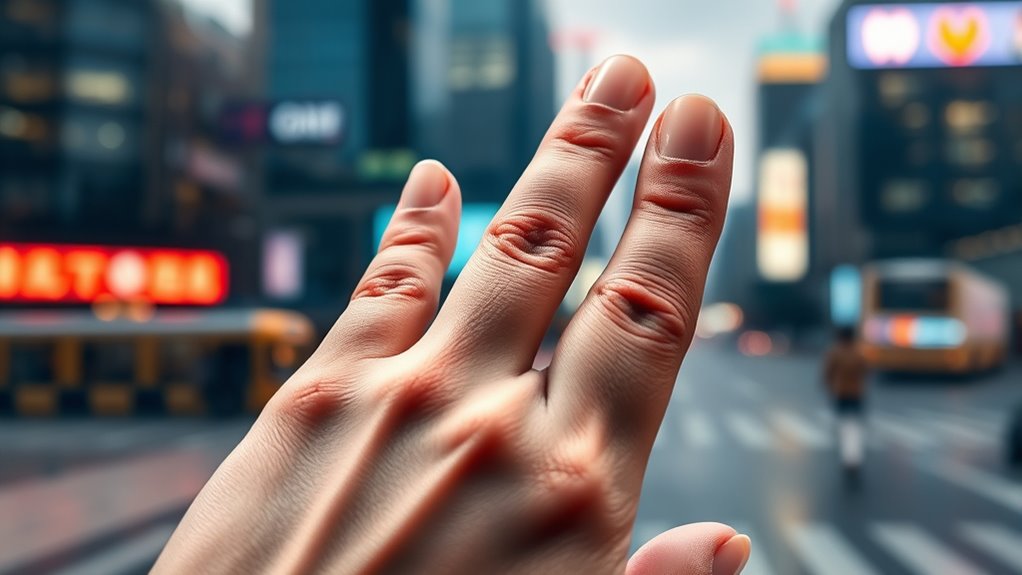
As digital communication continues to evolve, the 🤌 emoji is likely to adapt and take on new meanings. With ongoing emoji innovation, this symbol could become more versatile, reflecting changing social trends or cultural nuances. You might see it used to express appreciation, sophistication, or even sarcasm, depending on context. As messaging platforms introduce new features, the 🤌 emoji could gain animated versions or be integrated into augmented reality tools. This evolution helps keep digital conversations fresh and engaging. To stay ahead, pay attention to how you and others use the 🤌 emoji in different settings. This ongoing change mirrors the dynamic nature of digital communication, ensuring the 🤌 emoji remains relevant and expressive in future interactions. Additionally, understanding how to use airless paint sprayers correctly can enhance your project outcomes and keep your tools in top condition.
Frequently Asked Questions
Is the 🤌 Emoji Universally Understood Across All Cultures?
You should know that the 🤌 emoji isn’t universally understood across all cultures. Cultural interpretations and regional variations influence whether people recognize it as a gesture of excellence or precision. In some regions, it’s a common way to emphasize a point, while others might not understand it at all. So, when using the 🤌 emoji, consider your audience’s background to verify your message comes across as intended.
Can the 🤌 Emoji Be Considered Offensive in Any Context?
Have you ever wondered if your emoji use might offend someone? The 🤌 emoji can be considered offensive in certain contexts, especially when cultural sensitivities aren’t taken into account. It might be seen as a gesture of pride or arrogance in some cultures, leading to offensive interpretations. Be mindful of how this emoji is perceived, and always consider cultural differences to avoid unintentional offense.
How Does the 🤌 Emoji Differ From Similar Hand Gestures Like the “Chef’s Kiss”?
The 🤌 emoji differs from the chef’s kiss gesture by emphasizing a sense of excellence or perfection, often used to praise culinary gestures or something impressive. While the chef’s kiss involves a hand-to-mouth motion, the 🤌 emoji uses fingertips pinched together to symbolize finesse. Keep in mind, cultural differences influence its interpretation—what’s seen as positive in one culture may be misunderstood in another, so use it thoughtfully.
Are There Any Common Mistakes in Using the 🤌 Emoji?
You might be misusing the 🤌 emoji, leading to cultural misunderstandings. It’s often mistaken for a simple gesture of approval, but in some regions, it can be interpreted as offensive or as a sign of frustration. To avoid misused gestures, make sure you understand its cultural context before using it. By doing so, you prevent unintended offense and communicate your message clearly, respecting different interpretations across cultures.
Will the 🤌 Emoji Lose Popularity or Change Meaning Over Time?
You might see the 🤌 emoji’s popularity shift over time due to emoji evolution and cultural adaptation. As language and online trends change, its meaning could evolve or fade in some regions. However, if it continues to resonate culturally and stays relevant in conversations, it’ll likely maintain its significance. Staying aware of these shifts helps you understand how expressions adapt and how emojis like 🤌 evolve within digital communication.
Conclusion
Now that you know what the 🤌 emoji really means, aren’t you curious to try it out yourself? Whether you’re highlighting finesse or just adding flair to your messages, this emoji bridges culture and expression effortlessly. So, next time you want to show something’s first-rate or perfectly done, why not give the 🤌 a shot? After all, isn’t it time your texts matched your style?
